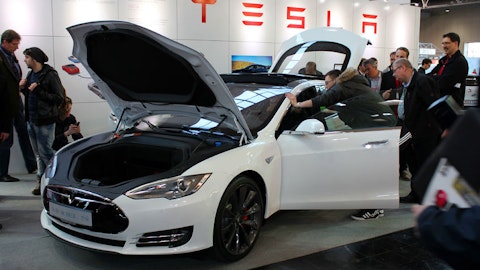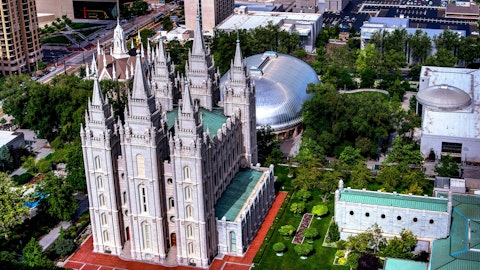Tesla, Inc. (NASDAQ:TSLA) Q4 2022 Earnings Call Transcript January 25, 2023
Martin Viecha: Good afternoon everyone and welcome to Tesla’s Fourth Quarter 2022 Q&A Webcast. My name is Martin Viecha, VP of Investor Relations and I’m joined today by Elon Musk, Zachary Kirkhorn and a number of other executives. Our Q4 results were announced at about 3:00 P.M. Central Time in the update deck we published at the same link as this webcast. During this call, we will discuss our business outlook and make forward-looking statements. These comments are based on our predictions and expectations as of today. Actual events or results could differ materially due to a number of risks and uncertainties, including those mentioned in our most recent filings with the SEC. During the Q&A session portion of today’s call, please limit yourself to one question and one follow-up. Please use the raise hand button to join the question queue. But before we jump into Q&A, Elon has some opening remarks. Elon?
Elon Musk: Thank you, Martin. So 2022 — just going through the 2022 recap. It was a fantastic year for Tesla. It was our best year ever on every level. Team did an amazing job. It’s an honor, of course, to work with such an incredibly talented group of people. So, in 2022, we delivered over 1.3 million cars and achieved a 17% operating margin, the highest among any volume carmaker, I think maybe among any carmaker. While doing so, we generated $12.5 billion in net income and $7.5 billion in free cash flow. Importantly, the Tesla team achieved these records while — despite the fact that 2022 was an incredibly challenging year due to forced shutdowns, very high interest rates, and many delivery challenges. So, it’s worth noting that all these records were in the face of massive difficulties.
Credit to the team for achieving that. The most common question we’ve been getting from investors is about demand. Thus far — so I want to put that concern to rest. Thus far in January, we’ve seen the strongest orders year-to-date than ever in our history. We currently are seeing orders at almost twice the rate of production. So, I mean, that — it’s not to say whether that will continue twice the rate of production, but the orders are high. And we’ve actually raised the Model Y price a little bit in response to that. So, we don’t — we think demand will be good despite probably a contraction in the automotive market as a whole. So, basically, price really matters. I think there’s just a vast number of people that want to buy a Tesla car, but can’t afford it.
And so these price changes really make a difference for the average consumer. And sometimes for those — for people who are well — who have a lot of money, they sort of forget about how important affordability is. And it’s always been our goal at Tesla to make cars that are affordable to as many people as possible, so I’m glad that we’re able to do so. And yes, so I think it’s a good thing, all things considered. We’re also making very good progress on cost control and we’re seeing the cost production in Berlin and Austin drop commensurate with the growth in production, as you’d expect, so yeah. With respect to Autopilot, as of now, we deployed whole self-driving Beta for city streets to roughly 400,000 customers in North America. This is a huge milestone for autonomy as FSD Beta is the only way any consumer can actually test the latest AI-powered autonomy.
And we’re currently at about 100 million miles of FSD outside of highways. And our published data shows that improvement in safety system — stuttering here, safety statistics, it’s very clear. So we would not have released the FSD Beta if the safety statistics were not excellent. Regarding batteries, production rate of 4680 cells reached 1,000 cars a week at the end of last year, and we’re increasing capacity for 4680 cells by another 100 gigawatt-hours as announced at Giga Nevada yesterday. Our long-term goal is to get to well in excess of 1,000 gigawatt-hours of cells produced internally and continue to use the self cell providers. So to be clear, we will continue to use other cell providers. Just that the demand for lithium ion batteries is quasi-infinite and will be for quite some time.
So we feel we can scale a lot faster using both suppliers and internally produced cells. And we’ve got an amazing plan for making the 4680 cell low-cost and high energy density. So energy storage also saw record growth and with that is continuing to accelerate. That’s always worth remembering that the three pillars of a sustainable energy future are obviously electric vehicles, solar and wind, and the third key item is stationary storage to store the energy from solar and wind because obviously, the sun doesn’t shine all the time and the wind doesn’t blow all the time. So you have those three things, you can convert all of it to a fully sustainable situation many times over, actually. So I would like to just make it clear that there is a path to a fully sustainable future for humanity, and we — our goal at Tesla is to accelerate progress on that path as much as humanly possible.
So yeah, so we were ramping up Megapack production. And we expect it to grow at a rate quite a bit faster than our legal output. So in conclusion, we are taking a view that we want to keep making and selling as many cars as we can. We believe we can keep pushing for strong volume growth while retaining the industry’s best operating margins. As we mentioned many times before, we want to be the best manufacturer. But really, manufacturing technology will be our most important long-term strength. And we’ll talk more about our upcoming plans at the March 1st Investor Day. And lastly, I want to once again thank all of our employees for delivering another record-breaking year. Congratulations, guys.
Martin Viecha: Thanks, Elon. And I think Zach has some opening remarks as well.

Zachary Kirkhorn: Yes. Thanks, Martin. So as Elon mentioned, 2022 was a terrific year for Tesla. I also want to congratulate the Tesla team and also say thank you to our suppliers for your support during quite a volatile year. On a full year basis, revenue increased over 50%. Operating income doubled, free cash flows increased over 50% and our margins remained industry-leading. Additionally, we continued to make progress on overhead efficiencies as non-GAAP OpEx as a percentage of revenue improved further. For Q4 specifically, sequential and annual margin was impacted by ASP reductions, as we are managing through COVID impacts in China, uncertainty around the consumer tax credit in the US, and a rising interest rate environment.
Note that in 2022, rising interest rates alone had effectively increased the price of our cars in the US by nearly 10%. Additionally, COGS per unit has increased on a year-over-year basis, driven primarily by three factors. First is raw materials and inflation led by lithium prices and discussed at length in previous calls. Second, we are working through the early ramp of inefficiencies of our Austin and Berlin and in-house cell production factories. Third, our vehicle mix over the last year has moved more heavily towards Model Y, which carries a slight cost premium to Model 3. Partially offsetting these impacts, we’ve continued to execute on Tesla controllable cost reductions, in line with the progress we’ve made in prior years. These improvements include our continued work to gradually move towards a regionally balanced build of vehicles.
The Energy business had its strongest year yet across all metrics, led by steady improvement in both retail and commercial storage. While much work remains to grow this business and improve costs, we believe we are on a good trajectory. As we look towards 2023, we are moving forward aggressively leveraging our strength and cost. There are three key points I wanted to make here. First, on demand, as Elon mentioned, customer interest in our products remains high. Second, on cost reduction, we’re holding steady on our plans to rapidly increase volume, while improving overhead efficiency, which is the most effective method to retain strength in our operating margins. In particular, we’re accelerating improvements in our new factories in Austin, Berlin and in-house cells, where efficiencies are the highest.
But we are attacking every other area of cost and unwinding cost increases created for multiple years of COVID-related instability. This includes logistics, expedites, accumulation of material buffers, part premiums, productivity and overheads as an example. As the world transitions from an inflationary to deflationary environment, we expect a strong partnership with our suppliers on this journey as well. In that, we’ve priced our products with a view towards a longer-term cost structure. Thus, there will be an impact on operating margin in the near term. However, we believe our margins will remain healthy and industry-leading over the course of the year. Third, we are continuing to ensure funding is prioritized for our long-term road map. This includes expanding in-house cell production, bringing Cybertruck to market, development of our next-generation vehicle platform, expansion of our manufacturing footprint and growth of the energy business.
We’re looking forward to discussing these plans in more detail on our Investor Day in a month. Thank you.
A – Martin Viecha: Thank you very much, Zach. Let’s now go to investor questions. The first question is, some analysts are claiming that Tesla orders, net of cancellations, came in at a rate less than half of production in the fourth quarter. This has raised demand concerns. Can you elaborate on order trends so far this year and how they compare to current production rates? I think.
See also 13 Cheap New Stocks To Buy and 11 Tech Stocks with Low PE Ratio.
Q&A Session
Follow Tesla Inc. (NASDAQ:TSLA)
Follow Tesla Inc. (NASDAQ:TSLA)
Elon Musk : We already answered that question.
Martin Viecha: Yes, exactly.
Elon Musk : Demand far exceeds production, and we actually are making some small price increases as a result.
Martin Viecha: Thank you. The second question is in a similar vein. What has the initial reaction been to global price reductions in early 1Q 2023, specifically in terms of order intake levels? We’ve answered that one as well. So let’s go to the next one. The next investor question is, will Tesla be able to take full advantage of advanced manufacturing production credits for battery cells packs? So $3,700 per long-range Model 3 and Model Y, it’s $45 a kilowatt-hour for autos and energy products and how much does Tesla expect to earn in the coming year from these credits?
Elon Musk: I’ll say a little bit about it, then I think Zach will add some. Long term, we expect these — the value of these credits to be very significant. You can do the math if we were to get anyone your 1,000 gigawatt-hours a year of production or even a few hundred gigawatt-hours, it’s very significant. So — but the credits do rely upon domestic manufacturing. And in the case of Panasonic domestic manufacturing, we’re splitting the value of the credits. So it — the value of credits this year will not be gigantic, but I think it could be gigantic — we think it probably will be very significant in the future.
Zachary Kirkhorn: Yes, just to add and input some boundaries on what we’re expecting in terms of impact to Tesla for this year. So different products, we think, will get different amounts of credit. The regulations here are still influx and there continues to be updates so this is just our best understanding at the moment. But we think on the order of $150 million to $250 million per quarter this year and growing over the course of the year as our volumes grow. And part of the work we’re doing here, which is part of what this incentive package is trying to incentivize is, as Elon mentioned, to move more manufacturing onshore in the United States, which is Tesla’s plans anyways. And so I think we’re pretty well positioned over the coming years to take advantage of this.
But then also part of what the goal of this incentive package is, is to improve adoption from our customers. And so we also want to use these incentives to improve affordability as we think about what the price points are in our products going forward. And so as we’re thinking about our pricing changes in the US, a couple of weeks ago that we announced, we were looking at what the credit benefit to Tesla would be to make sure that customers are able to receive the benefit not only from this that were received to some extent but also on the consumer-facing side, which is currently $7,500 per car of tax credit, assuming that — subject to the MSRP caps and the income caps. So we want to use this to accelerate sustainable energy, which is our mission and also the goal of this bill.
Martin Viecha: Thank you very much. The next question from investors is, after recent price cuts, analyst released expectations that Tesla automotive gross margin, excluding leasing and credits, will drop below 20% and average selling price around $47,000 across all models. Where do you see average selling price and gross margins after the price cuts?
Elon Musk: Yes, go ahead, Zach.
Zachary Kirkhorn: Yeah, I’ll jump in on this. So there is certainly a lot of uncertainty about how the year will unfold, but I’ll share what’s in our current forecast for a moment. So based upon these metrics here, we believe that we’ll be above both of the metrics that are stated in the question, so 20% automotive gross margin, excluding leases and rent credits and then $47,000 ASP across all models. And so two other comments I want to make on this. Just tactically on sequential ASP changes from Q4 to Q1. And just as a reminder, the ASP reduction is not as large as the reduction in configurator prices. As in Q4, we had backlog customers that we’re delivering cars to at a lower price book, given that backlogs had been so long for so much of 2022.
But then also, there are various programs in place that we used in Q4 that lowered ASPs. The second comment I wanted to make here is that as a management team here, we’re most focused on what our operating margin is. And so as other areas of the business become more important, particularly the energy business, which is growing faster than the vehicle business and as we’re heavily focused on operating leverage here, improving efficiency of our overheads, we think the right metric for us to be focused on is operating margin. And so I wanted to make sure that I shared that with the investor community as well, because that is what we’re primarily managing to now.
Elon Musk: Yes. Something that I think some of these smart retail investors understand, but I think a lot of others maybe don’t is that the — every time we sell a car, it has the ability, just from uploading software to have full self-driving enabled and full self-driving is obviously getting better very rapidly. So that’s actually a tremendous upside potential because all of those cars, with a few exceptions — I mean, only a small percentage of cars don’t have Hardware 3. So that means that there’s millions of cars were full self-driving can be sold at essentially 100% gross margin. And the value of it grows as the autonomous capability grows. And then when it becomes fully autonomous, that is a value increase in the fleet. That might be the biggest asset value increase of anything in history. Yeah.
Martin Viecha: Thank you. Let’s go to the next investor question. Since Elon started political influencing, polls from Morning Consult and YouGov show
Elon Musk: YouGov, crush that with your left.





